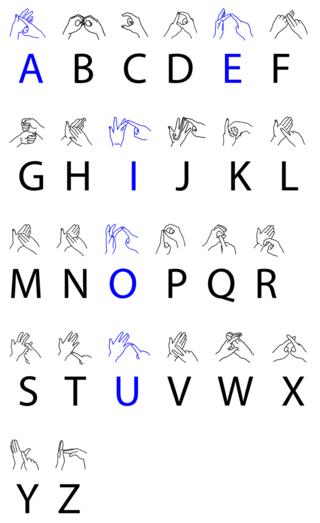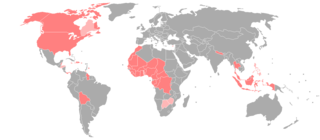Related Research Articles

American Sign Language (ASL) is a natural language that serves as the predominant sign language of Deaf communities in the United States of America and most of Anglophone Canada. ASL is a complete and organized visual language that is expressed by employing both manual and nonmanual features. Besides North America, dialects of ASL and ASL-based creoles are used in many countries around the world, including much of West Africa and parts of Southeast Asia. ASL is also widely learned as a second language, serving as a lingua franca. ASL is most closely related to French Sign Language (LSF). It has been proposed that ASL is a creole language of LSF, although ASL shows features atypical of creole languages, such as agglutinative morphology.

Fingerspelling is the representation of the letters of a writing system, and sometimes numeral systems, using only the hands. These manual alphabets have often been used in deaf education and have subsequently been adopted as a distinct part of a number of sign languages. There are about forty manual alphabets around the world. Historically, manual alphabets have had a number of additional applications—including use as ciphers, as mnemonics and in silent religious settings.

Sign languages are languages that use the visual-manual modality to convey meaning, instead of spoken words. Sign languages are expressed through manual articulation in combination with non-manual markers. Sign languages are full-fledged natural languages with their own grammar and lexicon. Sign languages are not universal and are usually not mutually intelligible, although there are also similarities among different sign languages.
International Sign (IS) is a pidgin sign language which is used in a variety of different contexts, particularly at international meetings such as the World Federation of the Deaf (WFD) congress, in some European Union settings, and at some UN conferences, at events such as the Deaflympics, the Miss & Mister Deaf World, and Eurovision, and informally when travelling and socialising.

British Sign Language (BSL) is a sign language used in the United Kingdom (UK), and is the first or preferred language among the Deaf community in the UK. Based on the percentage of people who reported 'using British Sign Language at home' on the 2011 Scottish Census, the British Deaf Association estimates there are 151,000 BSL users in the UK, of which 87,000 are Deaf. By contrast, in the 2011 England and Wales Census 15,000 people living in England and Wales reported themselves using BSL as their main language. People who are not deaf may also use BSL, as hearing relatives of deaf people, sign language interpreters or as a result of other contact with the British Deaf community. The language makes use of space and involves movement of the hands, body, face, and head.

Yoruba is a language spoken in West Africa, primarily in Southwestern and Central Nigeria. It is spoken by the ethnic Yoruba people. The number of Yoruba speakers is roughly 50 million, plus about 2 million second-language speakers. As a pluricentric language, it is primarily spoken in a dialectal area spanning Nigeria and Benin with smaller migrated communities in Côte d'Ivoire, Sierra Leone and The Gambia.
Nicaraguan Sign Language is a form of sign language which developed spontaneously among deaf children in a number of schools in Nicaragua in the 1980s. It is of particular interest to linguists as it offers them a unique opportunity to study what they believe to be the birth of a new language.
Auslan is the majority sign language of the Australian Deaf community. The term Auslan is a portmanteau of "Australian Sign Language", coined by Trevor Johnston in the 1980s, although the language itself is much older. Auslan is related to British Sign Language (BSL) and New Zealand Sign Language (NZSL); the three have descended from the same parent language, and together comprise the BANZSL language family. Auslan has also been influenced by Irish Sign Language (ISL) and more recently has borrowed signs from American Sign Language (ASL).
Nigerian Pidgin, also called Naijá or Naija, is an English-based creole language spoken as a lingua franca across Nigeria. The language is sometimes referred to as "Pijin" or Broken. It can be spoken as a pidgin, a creole, slang or a decreolised acrolect by different speakers, who may switch between these forms depending on the social setting. In the 2010's, a common orthography was developed for Pidgin which has been gaining significant popularity in giving the language a harmonized writing system.

The culture of Nigeria is shaped by Nigeria's multiple ethnic groups. The country has 527 languages, seven of which are extinct. Nigeria also has over 1150 dialects and ethnic groups. The three largest ethnic groups are the Hausas that are predominantly in the north, the Yorubas who predominate in the southwest, and the Igbos in the southeast. There are many other ethnic groups with sizeable populations across the different parts of the country. The Kanuri people are located in the northeast part of Nigeria, the Tiv people of north central and the Efik-Ibibio are in the south south. The Bini people are most frequent in the region between Yorubaland and Igboland.
Japanese Sign Language, also known by the acronym JSL, is the dominant sign language in Japan and is a complete natural language, distinct from but influenced by the spoken Japanese language.
Indo-Pakistani Sign Language (IPSL) is the predominant sign language in the subcontinent of South Asia, used by at least 15 million deaf signers. As with many sign languages, it is difficult to estimate numbers with any certainty, as the Census of India does not list sign languages and most studies have focused on the north and urban areas. As of 2021, it is the most used sign language in the world, and Ethnologue ranks it as the 151st most "spoken" language in the world.
Manually coded languages (MCLs) are a family of gestural communication methods which include gestural spelling as well as constructed languages which directly interpolate the grammar and syntax of oral languages in a gestural-visual form—that is, signed versions of oral languages. Unlike the sign languages that have evolved naturally in deaf communities, these manual codes are the conscious invention of deaf and hearing educators, and as such lack the distinct spatial structures present in native deaf sign languages. MCLs mostly follow the grammar of the oral language—or, more precisely, of the written form of the oral language that they interpolate. They have been mainly used in deaf education in an effort to "represent English on the hands" and by sign language interpreters in K-12 schools, although they have had some influence on deaf sign languages where their implementation was widespread.

Gun is a language in the Gbe languages group. It is spoken by the Ogu people in Benin, as well as in south-western Nigeria. Gun is part of the Fon cluster of languages inside the Eastern Gbe languages; it is close to Fon, especially its Agbome and Kpase varieties, as well as to the Maxi and Weme (Ouémé) languages. It is used in some schools in the Ouémé Department of Benin.

The Yoruba people are a West African ethnic group that mainly inhabit parts of Nigeria, Benin, and Togo. The areas of these countries primarily inhabited by Yoruba are often collectively referred to as Yorubaland. The Yoruba constitute more than 42 million people in Africa, are a few hundred thousand outside the continent, and bear further representation among members of the African diaspora. The vast majority of the Yoruba population is today within the country of Nigeria, where they make up 21% of the country's population according to CIA estimations, making them one of the largest ethnic groups in Africa. Most Yoruba people speak the Yoruba language, which is the Niger-Congo language with the largest number of native or L1 speakers.
Bura Sign Language is a village sign language used by the Bura people around the village of Kukurpu, 40 km south-east of Biu, Nigeria, an area with a high degree of congenital deafness. What little is known about it is due to a brief visit and a videotape by Robert Blench in 2003. It is "likely ... quite independent" from other, better-known sign languages such as Nigerian Sign Language, since none of the signers have been to school and the area where it is used is rather remote.
The deaf community over time has worked to improve the educational system for those who are deaf and hard of hearing. The history of deaf education dates back to Ancient Egypt where the deaf were respected and revered. In contrast, those who were deaf in Ancient Greece were considered a burden to society and put to death. The educational aspects of the deaf community has evolved tremendously and still continues to grow as the science of linguistics, educational research, new technologies, and laws, on local, national, and international levels are steadily being introduced. Strategies, however, remain controversial.
A village sign language, or village sign, also known as a shared sign language, is a local indigenous sign language used by both deaf and hearing in an area with a high incidence of congenital deafness. Meir et al. define a village sign language as one which "arise[s] in an existing, relatively insular community into which a number of deaf children are born." The term "rural sign language" refers to almost the same concept. In many cases, the sign language is known throughout the community by a large portion of the hearing population. These languages generally include signs derived from gestures used by the hearing population, so that neighboring village sign languages may be lexically similar without being actually related, due to local similarities in cultural gestures which preceded the sign languages. Most village sign languages are endangered due to the spread of formal education for the deaf, which use or generate deaf-community sign languages, such as a national or foreign sign language.

The Yoruba tribal marks are scarifications which are specific identification and beautification marks designed on the face or body of the Yoruba people. The tribal marks are part of the Yoruba culture and are usually inscribed on the body by burning or cutting of the skin during childhood. The primary function of the tribal marks is for identification of a person's tribe, family or patrilineal heritage. Other secondary functions of the marks are symbols of beauty, Yoruba creativity and keeping mischievous children alive. This practice was popular among Yoruba people of Nigeria, Benin, and Togo. During the trans-Atlantic slave trade, tribal identification and facial stripes became important. Some repatriated slaves later reunited with their communities by looking at facial stripes.

American Sign Language (ASL) developed in the United States and Canada, but has spread around the world. Local varieties have developed in many countries, but there is little research on which should be considered dialects of ASL and which have diverged to the point of being distinct languages.
References
- ↑ Ọlanikẹ Ọla Orie (2013) "From Conventional Gestures to Sign Language: The Case of Yoruba Sign Language". In Orie & Sanders (eds), Selected Proceedings of the 43rd Annual Conference on African Linguistics: Linguistic Interfaces in African Languages. Somerville, MA: Cascadilla Proceedings Project
- Olanike Ola Orie (2012) Acquisition Reversal: The Effects of Postlingual Deafness in Yoruba. Walter de Gruyter.